Chief Justice of the United States
(Redirected from U.S. Chief Justice)
The Chief Justice of the United States is the senior judge of the Supreme Court of the United States.
They have no more powers than any of the other judges of the Supreme Court, who are called Associate Justices. The Chief Justice is responsible for organizing the Court's schedules and administration.
By tradition, the Chief Justice administers the oath of office to the President of the United States. The only time this has not happened is when Calvin Coolidge became president.
List of chief justices
| Chief Justice | Date confirmed (Vote) |
Tenure[a] | Tenure length | Appointed by | Prior position[b] | ||
|---|---|---|---|---|---|---|---|
| 1 | 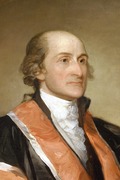
|
John Jay (1745–1829) |
September 26, 1789 (Acclamation) |
October 19, 1789 – June 29, 1795 (resigned) |
5 years, 253 days | George Washington | Acting United States Secretary of State (1789–1790) |
| 2 | 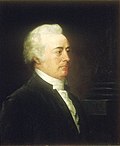
|
John Rutledge (1739–1800) |
December 15, 1795 (10–14)[c] |
August 12, 1795[d] – December 28, 1795 (resigned, nomination having been rejected) |
138 days | Chief Justice of the South Carolina Court of Common Pleas and Sessions (1791–1795) Associate Justice of the Supreme Court (1789–1791) | |
| 3 | 
|
Oliver Ellsworth (1745–1807) |
March 4, 1796 (21–1) |
March 8, 1796 – December 15, 1800 (resigned) |
4 years, 282 days | United States Senator from Connecticut (1789–1796) | |
| 4 | 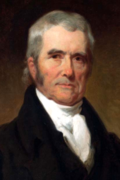
|
John Marshall (1755–1835) |
January 27, 1801 (acclamation) |
February 4, 1801 – July 6, 1835 (died) |
34 years, 152 days | John Adams | 4th United States Secretary of State (1800–1801) |
| 5 | 
|
Roger B. Taney (1777–1864) |
March 15, 1836 (29–15) |
March 28, 1836 – October 12, 1864 (died) |
28 years, 198 days | Andrew Jackson | 12th United States Secretary of the Treasury (1833–1834) |
| 6 | 
|
Salmon P. Chase (1808–1873) |
December 6, 1864 (acclamation) |
December 15, 1864 – May 7, 1873 (died) |
8 years, 143 days | Abraham Lincoln | 25th United States Secretary of the Treasury (1861–1864) |
| 7 | 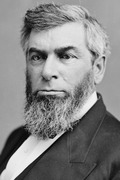
|
Morrison Waite (1816–1888) |
January 21, 1874 (63–0) |
March 4, 1874 – March 23, 1888 (died) |
14 years, 19 days | Ulysses S. Grant | Ohio State Senator (1849–1850) Presiding officer, Ohio constitutional convention (1873) |
| 8 | 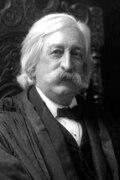
|
Melville Fuller (1833–1910) |
July 20, 1888 (41–20) |
October 8, 1888 – July 4, 1910 (died) |
21 years, 269 days | Grover Cleveland | President, Illinois State Bar Association (1886) Illinois State Representative (1863–1865) |
| 9 | 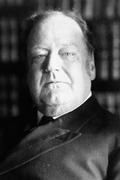
|
Edward Douglass White (1845–1921) |
December 12, 1910[e] (acclamation) |
December 19, 1910 – May 19, 1921 (died) |
10 years, 151 days | William Howard Taft | Associate Justice of the Supreme Court (1894–1910) |
| 10 | 
|
William Howard Taft (1857–1930) |
June 30, 1921 (acclamation) |
July 11, 1921 – February 3, 1930 (retired) |
8 years, 207 days | Warren G. Harding | 27th President of the United States (1909–1913) |
| 11 | 
|
Charles Evans Hughes (1862–1948) |
February 13, 1930 (52–26) |
February 24, 1930 – June 30, 1941 (retired) |
11 years, 126 days | Herbert Hoover | 44th United States Secretary of State (1921–1925) Associate Justice of the Supreme Court (1910–1916) |
| 12 | 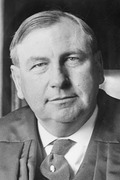
|
Harlan F. Stone (1872–1946) |
June 27, 1941[e] (acclamation) |
July 3, 1941 – April 22, 1946 (died) |
4 years, 293 days | Franklin D. Roosevelt | Associate Justice of the Supreme Court (1925–1941) |
| 13 | 
|
Fred M. Vinson (1890–1953) |
June 20, 1946 (acclamation) |
June 24, 1946 – September 8, 1953 (died) |
7 years, 76 days | Harry S. Truman | 53rd United States Secretary of the Treasury (1945–1946) |
| 14 | 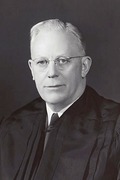
|
Earl Warren (1891–1974) |
March 1, 1954 (acclamation) |
October 5, 1953[d] – June 23, 1969 (retired) |
15 years, 261 days | Dwight D. Eisenhower | 30th Governor of California (1943–1953) |
| 15 | 
|
Warren E. Burger (1907–1995) |
June 9, 1969 (74–3) |
June 23, 1969 – September 26, 1986 (retired) |
17 years, 95 days | Richard Nixon | Judge of the United States Court of Appeals for the District of Columbia Circuit (1956–1969) |
| 16 | 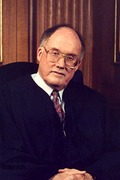
|
William Rehnquist (1924–2005) |
September 17, 1986[e] (65–33) |
September 26, 1986 – September 3, 2005 (died) |
18 years, 342 days | Ronald Reagan | Associate Justice of the Supreme Court (1972–1986) |
| 17 | 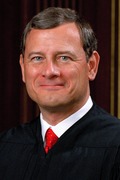
|
John Roberts (born 1955) |
September 29, 2005 (78–22) |
September 29, 2005 – Incumbent |
20 years, 74 days | George W. Bush | Judge of the United States Court of Appeals for the District of Columbia Circuit (2003–2005) |
Chief Justice Of The United States Media
Notes
- ↑ The start date given here for each chief justice is the day they took the oath of office, and the end date is the day of the justice's death, resignation, or retirement.
- ↑ Listed here (unless otherwise noted) is the position—either with a U.S. state or the federal government—held by the individual immediately prior to becoming Chief Justice of the United States.
- ↑ This was the first Supreme Court nomination to be rejected by the United States Senate. Rutledge remains the only "recess appointed" justice not to be subsequently confirmed by the Senate.
- ↑ 4.0 4.1 Recess appointment. Note: the date on which the justice took the judicial oath is here used as the date of the beginning of their service, not the date of the recess appointment.
- ↑ 5.0 5.1 5.2 Elevated from associate justice to chief justice while serving on the Supreme Court. The nomination of a sitting associate justice to be chief justice is subject to a separate confirmation process.








